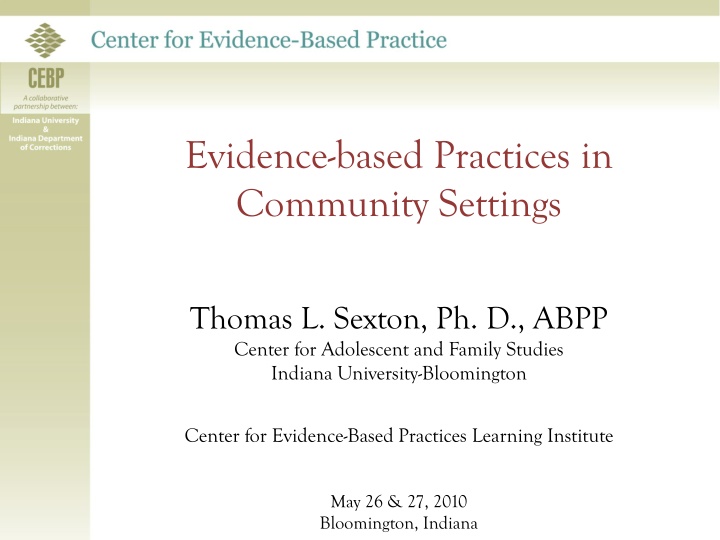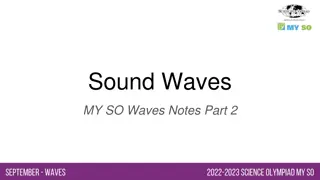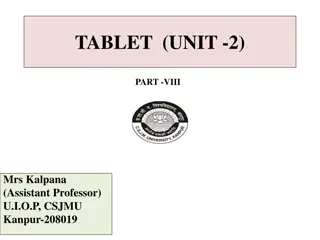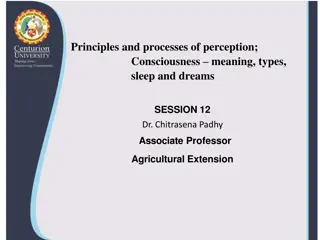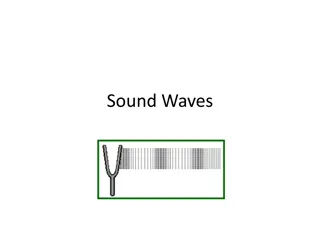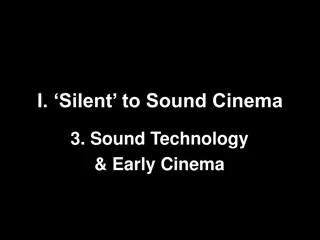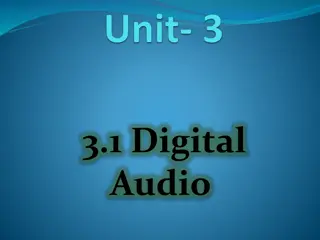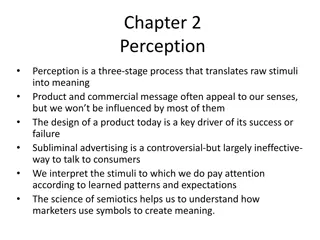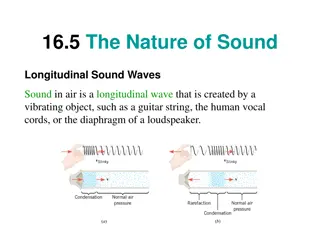Sound in Film: Shaping Perception
Pivotal role of sound in film, this content delves into how sound elements such as loudness, pitch, timbre, silence, rhythm, and fidelity actively influence our interpretation of visual images. By examining the interplay between sound and image, a deeper understanding of cinematic storytelling is achieved."
Download Presentation

Please find below an Image/Link to download the presentation.
The content on the website is provided AS IS for your information and personal use only. It may not be sold, licensed, or shared on other websites without obtaining consent from the author.If you encounter any issues during the download, it is possible that the publisher has removed the file from their server.
You are allowed to download the files provided on this website for personal or commercial use, subject to the condition that they are used lawfully. All files are the property of their respective owners.
The content on the website is provided AS IS for your information and personal use only. It may not be sold, licensed, or shared on other websites without obtaining consent from the author.
E N D
Presentation Transcript
Evidence-based Practices in Community Settings Thomas L. Sexton, Ph. D., ABPP Center for Adolescent and Family Studies Indiana University-Bloomington Center for Evidence-Based Practices Learning Institute May 26 & 27, 2010 Bloomington, Indiana
Introduction Evidence based practices have become part of our common language Education Medicine Psychology and everything else Evidence-based practice is a philosophical approach that is in opposition to rules of thumb, folklore, and tradition (the way it has always been done) EBM aims for the ideal that professional should make conscientious, explicit, and judicious use of current
The Promise of Evidence Based Practices In all domains EBP promised: Improved outcomes Cost savings Increased accountability Development of new programs to meet new needs That promise can only be realized if EBP work in community based settings . in real practice
The Decade of EBP It has been a decade of EBP Lists of practices (mental health, medicine, education) U. S.. National Registry of Evidence-Based Practices and Programs (NREPP) Centers/Web sites EBP implemented in numerous communities and now having an impact on training, practice, and funding Washington State---EBP only for Juvenile programs Oregon-EBP only ones paid for by State Individual agencies who have EBP for each of their major areas Large systems that adopted the goal/aspiration of EBP
EBP in Justice &Community Corrections 1990 the Surgeon General declared, nothing works Findings its place in community corrections Specific Programs/Practices (most for Juveniles) National Institutes for Corrections (NIC) 8 principles of evidence based community corrections Crime and Justice Institute & NIC Box Set series of white papers share information with criminal justice system stakeholders about how the implementation of evidence-based practices (EBP) and a focus on recidivism reduction affect their areas of expertise in pretrial services, judiciary, prosecution, defense, jail, prison, and treatment.
Success of EBP Millions of youth, adults, and families helped in ways that: Worked, over time, in a way that fit them Help them become productive citizens Reduced community risk Improved functioning for next generations (through families) Saved money .
Washington State Institute for Public Policy EVIDENCE-BASED PUBLIC POLICY OPTIONS TO REDUCE FUTURE PRISON CONSTRUCTION, CRIMINAL JUSTICE COSTS, AND CRIME RATES
Know what might work We know more of what does and does not work based on using evidence Adults on Parole/Probation Vocational Education in Prison General Education in Prison Electronic Monitoring (to reduce time) Sex offender treatment in prison Intensive Supervision $13,738 $10,669 $4,359 $870 $-3,328
Know what might work Juvenile & Adults Prevention Programs Juvenile Drug Courts FFT Juvenile Intensive Supervision 1,201 Counseling Psychotherapy $4,622 $31,821 $- $-14,667
The Reality of EBP Despite the use, awareness, and implementation EBP have along way to go .. Confusing terms ..in what they are? What it takes to successfully implement, sustain, and integrate EBP into the community system And .it is more complex when moved to community settings Not everything works, is cost effective, can be implemented
Evidence-based Practices in Community Settings However ..what works in the lab doesn t always work in the community 50% reduction in ES Few programs last beyond the grant period Few programs are adapted and integrated into the system Many practices/Programs that are business as usual go unaddressed Really don t know what is happening in implementation/outcome
Goals of this Presentation 1. Expand the meaning of EBP to one that fits community settings 2. Present an integrated approach to EBP in community settings. One that fits . Programs General practices Organizational philosophy Evidence-based Systems 3. Give some examples of how the CEBP is helping accomplish these goals 4. Next steps of CEBP in moving this integrated model forward
Evidence-based Practices in Community Settings in the real world What are they? What is necessary for them to work? Adopting an Integrated Evidence-Based System of Community Corrections
Evidence-Based Practices/Programs An evidence-based program: a specific program that has demonstrated the probability of success with clients/problems for which it was designed For a program to be considered evidence-based it must demonstrate relevant outcomes in: scientific (clinical trial) and clinical relevant (community effectiveness) situations, transportability to practitioners (replicable beyond model/intervention developers), applicable to diverse clients and therapists.
In the real world EBP are not easy 1. Complex/diverse/extensive problems 2. Require systems not just programs being evidence based means . Philosophy Common practices Specific programs Quality improvement practices (ongoing data monitoring) 3. Little ongoing data monitoring What goes on in a study constant monitoring 4. Every new practice/program requires adaptation Question is how ..using data to see is best (not just comfort) Starting a EBP is not end just beginning 5. EBP are not always funded and supported 6. Expensive 7. Limited Use
EBP work in Community Settings What we have learned What is emerging is an idea that definition/meaning of EBT needs to be expanded Move away from the idea of programs that work Focus on evidence based systems with: Programs that fit local need Core practices that accomplish certain needed outcomes Ongoing monitoring/evaluation for quality improvement
Confusing Terms Best practice Best practices are often based on the collective experience and wisdom of the field rather scientifically tested knowledge. Do not necessarily imply attention to outcomes, evidence, or measurable standards. What works What works implies linkage to general outcomes, but does not specify the kind of outcomes desired (e.g. just desserts, deterrence, organizational efficiency, rehabilitation, etc.).
Terms Evidence based practice 1. Specific program/practice 2. definable outcomes 3. measurable; and 4. defined according to practical realities (recidivism, victim satisfaction, etc.). Terms are different imply different levels of specificity Different levels of outcome, cost effectiveness
Community Based Definition of EBP 1. EBP Philosophy a questioning approach to practice leading to scientific experimentation System of continuous quality improvement 2. Continuous measurement/monitoring/feedback meticulous observation, enumeration, and analysis replacing anecdotal case description 3. Practices that reliably produce desired outcomes 4. Integrated into 1. Philosophy/culture 2. Common practices 3. Specific programs 4. Policy development
5. Attention to Systematic Implementation 6. CQI culture Require ongoing data monitoring Systematic Adaptation Ongoing program evaluation 7. Supported by necessary resources Research help/guidance Technical Assistance (finding information, gaining resources etc)
Evidence-Based Practices Adaptation 8. Policy and Funding Support/encouragement/support Not for existing (business as usual) but for demonstrating, adapting, having a CQI culture 9. Local Adaptation & Local Ownership EBP It recognizes that care is individualized and ever changing and involves uncertainties and probabilities Program owned by the community
Center for Evidence-Based Practices IDOC and IU Bringing EBP into the real world
Goal of the CEBP EBP Technical Assistance Center to provide on going community based technical assistance to help local communities move toward evidence based practices Independent Research & Evaluation Center: To identify Current practices, capacity and needs for different EBP outcome of outcomes of community-based services Determine the cost effectiveness of Community based Services Advisory Board: Community Corrections Directors IDOC CAFS
Research Institute 1. Outcomes: Survey of Community based Practices (2008-2009) 1. 2. 3. Improvements in data collection Administrative changes to quarterly/final reports New questions to study 2. Specific studies (2009-2010) ** 1. Outcome study of CC Practices 2. Range of Programs 3. Efficacy of Thinking for a Change 4. Range of Juvenile Programing
CEBP Technical Assistance Center Provide aid to Communities/IDOC to help realize the goal of an EBP System Essential if Communities are going to move beyond business as usual Accomplishments: CEBP Learning Institutes EBP Information Clearing House ** What s next: Learning Modules (Web based training) Local TA
Technical Assistance Information to communities (to make decisions they need to make): CEBP information clearing house Implementation (FFT in Howard, Adult FFT in Monroe County) Learning Institutes (this conference) Goal: Match needs with practices (that work) Identify/implement new programs Adapt/adjust existing program Make policy/funding decisions
Contact Information: Thomas L. Sexton, Ph. D, ABPP thsexton@indiana.edu
